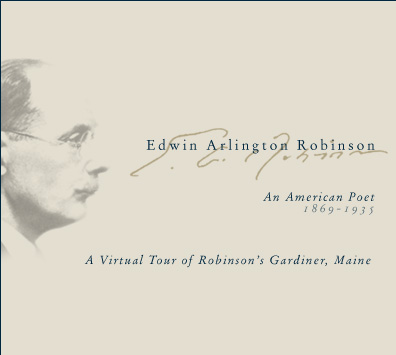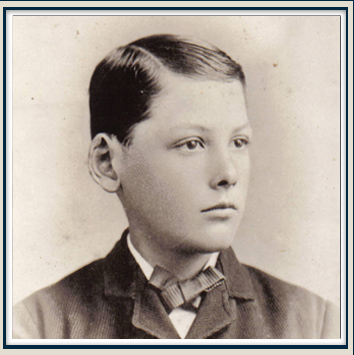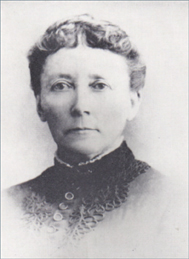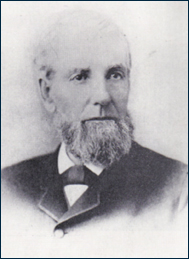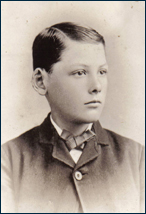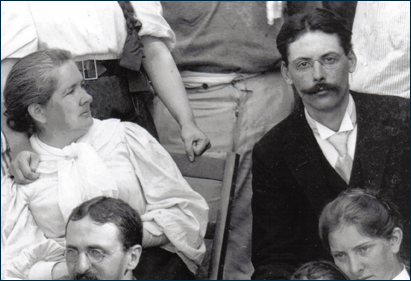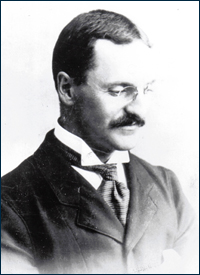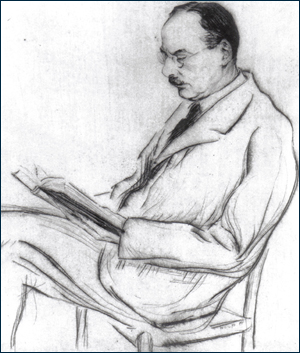|
|||||||||||||||||||
|
|
|||||||||||||||||||
Edwin Arlington Robinson was born in the village of Head Tide in the town of Alna, Maine, on December 22, 1869, third son of Edward and Mary Elizabeth (Palmer) Robinson. Because his mother had expected a daughter, no male name had been selected for a possible son. The following summer when the family vacationed at a resort in Harpswell, Maine, the ladies on the verandah challenged her to name the baby. The ladies placed names in a lottery, and the name drawn was “Edwin.” Because the lady who proposed “Edwin” as a name was from Arlington, Massachusetts, baby Robinson became Edwin Arlington Robinson, a name that was anathema to him throughout his life. He hated the family’s habit of calling him “Win,” and as an adult he always signed himself as “E. A.”
The father was a successful lumber merchant and local politician in Alna, and as he acquired wealth, he was offered the directorship of a bank in Gardiner, to which place the family moved when Robinson was eighteen months old. The family moved into the S. W. Bates house on Lincoln Street, now Avenue, in September 1870. His first schooling was at Mrs. Morrell’s School on Dresden Avenue, a short walk from the Robinson house through connecting Danforth Street. The Robinson family worshipped at the Congregational Church at the top of Brunswick Hill. Later he attended public schools and graduated from Gardiner High School, then located on the corner of School Street and Dresden Avenue across from the Gardiner Common. There he may have had a childhood crush on his teacher Lizzie Austin. The graduation ceremony was held in the Gardiner Coliseum, a convention hall, in June 1888. His honor part was “Muliera, a Metrical Discourse,” the text of which has never been found.
Robinson, a shy and quiet child, was utterly fascinated by the sound of words. He early became “an incorrigible fisher of words” as he reflected upon the matter late in his life. His neighbors, the Jordans, said that his greatest delight seemed to be “hunting difficult words.” He would appear in their doorway, and cry “Nebuchadnezzar” or “Melchizedek.” However, his early life in Gardiner was not as isolated as some accounts would suppose. He swam in Kennebec River with the Swanton brothers, picked apples with the Barstow brothers, and sneaked cigarettes in Deane’s Grove. Taller than his contemporaries, he appeared gaunt and uncoordinated. That he had no athletic skills (in stark contrast with his handsome and poised brother Herman) must have created the impression that he was a loner. Late in life Robinson wrote, “It must have been the year 1889 when I realized finally — that I was doomed, or elected, or sentenced for life, to the writing of poetry. There was nothing else that interested me.” At this time he introduced himself to the homeopathic physician Dr. Alanson Tucker Schumann, a neighbor across the ravine from the Robinson house. Dr. Schumann immediately recognized Robinson’s talent and spared no effort to tutor him in formal poetic forms such as sonnets, ballads, and villanelles. Then Dr. Schumann introduced him to the Gardiner Poetry Group that met weekly in the residence of Caroline Swan. Another Gardiner lyricist and composer, Kate Vannah, was a peripheral member of the poetry circle in Gardiner. The second son in the Robinson family, Herman, married Emma Shepherd from Farmingdale. “Win” also had courted Emma and expected to marry her. Herman’s marriage was a great blow to his pride. During the marriage ceremony, February 12, 1890, the despondent poet stayed home and wrote a poem of protest, “Cortège.” The poem refers to the train that took the newly married couple out of town to their new life in St. Louis, Missouri. Since the 1965 publication, Where the Light Falls, the lovers’ triangle has become a central theme in Robinson’s biography and the interpretation of his poetry. While his brothers, Dean and Herman, pursued careers in medicine and business, Robinson wrote. After high school he attended Harvard College where his intellectual interests and his circle of friends broadened. Two years later his family suffered severe financial losses in the panic of 1893. Robinson’s studies came to an end, and he returned to Gardiner. During this dismal period, Robinson found solace in corresponding with his friend Harry De Forest Smith, then a student at Bowdoin, and frequently visited Smith’s parents at the family home on Iron Mine Hill. They envisioned a translation of Greek poetry.
Back in Gardiner, Robinson formed a small poetry and philosophy group called the Quadruped Club where he often read drafts of his poems. In 1896 he self-published his first book, The Torrent and the Night Before (the first half of the title referring to the waterfall on Rolling Dam Brook). Another poem in this book, “The Clerks of Time” was associated with J. T. Stone’s Dry Good’s Store. His first book received several positive reviews, and Robinson soon reworked the collection into his first commercial publication, The Children of the Night. Then Robinson’s Annus Horrbilis (year of woes) started. His father died soon after the demise of the family fortune. His mother died of diphtheria in 1896, a few days before he received the shipment of his first book. In 1899 his beloved elder brother, Dr. H. Dean Robinson, died from a drug overdose. Dean had operated a pharmacy. Eventually Herman Robinson failed in business after making many faulty investments. He then sank slowly into alcoholism. Incidentally, his investment in the poorly run Jasper Mines gave rise to the title of Robinson’s last book of poetry, King Jasper. Herman’s death was viewed by Emma herself as the basis of Robinson’s most famous poem, “Richard Cory.” The new biography of Robinson espouses this view and rejects the 1938 Herman Hagedorn attribution of Sedgewick Plummer. There is no evidence that Robinson had any knowledge of Plummer, and therefore the Plummer house on Brunswick Avenue is purposely omitted from the list of Robinson sites. Even before Herman’s death, Emma and their three daughters, Ruth, Marie, and Barbara, were reduced to poverty. Creditors seized the Robinson house on Lincoln Avenue, forcing Emma and her daughters to rejoin the Shepherd family in Farmingdale. After Herman’s death, Emma rejected two further proposals of marriage from “Win.” It is ironic that the youngest Robinson brother who was viewed (at least in his estimation) as a failure by the community should earn enough money to support his brother’s heirs.
Before permanently leaving Gardiner, Robinson forged one of the most important friendships in his life: Laura E. Richards (1850–1943), the writer of children’s books and benefactor of many public institutions in Gardiner, including the founding of the Gardiner Public Library. When The Torrent and the Night Before was published, she invited him to visit her at the Richards family residence, the Yellow House. Her daughter Alice Richards (1872–1922) introduced Robinson to classical music. There he also met Rosalind Richards (1874–1964), celebrated as the “Woodland Maiden” in Hagedorn’s biography. Robinson’s flirtations with Rosalind withered on the vine. Laura Richards, together with her husband’s cousin, Professor John Hays Gardiner of Harvard, guaranteed the publication of Robinson’s second volume, Children of the Night.
Professor Gardiner also bequeathed Robinson a substantial cash sum at the final phase of Robinson’s down-and-out period in New York City, thus furnishing the final safety net that he needed before success came to him. But more importantly, Richards wrote to Robinson every week for the remainder of his life. Her unrelenting attention to Robinson may have provided yet another safety net because Richards’ daughter, Elizabeth Wiggins, told the present writer in 1980 that her mother feared that Robinson may have had suicidal thoughts that she helped him to overcome. After a failed attempt to serve President Lowell of Harvard as a confidential secretary, Robinson permanently settled in New York. There he lived in dire poverty and became alcoholic. He took odd jobs and depended upon the financial support of friends to give him time to write. In 1904, his fortune started to turn. Kermit Roosevelt, then a student at Groton School, gave his father, Theodore Roosevelt, then president of the United States, a copy of The Children of the Night. Henry Howe Richards (1876–1968), elder son of Laura E. Richards, had introduced Kermit to Robinson’s publications. President Roosevelt so admired the poems that he persuaded a publisher to reprint The Children of the Night, wrote a review of it, and found a sinecure for Robinson at the U. S. Customs Office. (In fact, as Edmund Morris points out in his second volume of the Roosevelt biography, this was the only sinecure that the reform-minded president ever granted.) When Robinson published The Town Down the River in 1910, he dedicated it to the president.
Robinson’s struggles were not yet over, but his path did become easier. He was invited to the MacDowell Colony in 1911, liked it, and continued to spend summers there until his death. In 1922 he received his first Pulitzer Prize, followed by two more in 1925 and 1928. Thus it is remarkable that counting the Pulitzer Prize that Laura Richards received for her two-volume biography of her mother, Julia Ward Howe, that Gardiner, Maine, writers acquired four Pulitzer Prizes within one decade. Robinson published twenty-eight books of poetry in his lifetime. He remains best known for his “Tilbury Town” poems. The first mention of Tilbury Town (a mythical place that Robinson reluctantly conceded might have represented Gardiner “in a shadowy way”) appears in “John Everldown” published in The Torrent and the Night Before. Robinson died of cancer on April 6, 1935 in the New York Hospital (now New York Cornell Hospital) in New York City. It is a strange coincidence that the architect of the hospital, Henry R. Shepley, was related to the Richards family by marriage and eventually designed the memorial to Robinson on the Gardiner Common. Robinson’s ashes were returned to Gardiner, and shortly before their interment in the Palmer-Robinson plot in the Oak Grove Cemetery, pressed blossoms from the loves of his life, Emma Robinson and Rosalind Richards, were sealed within the urn.
|
|
||||||||||||||||||
|
